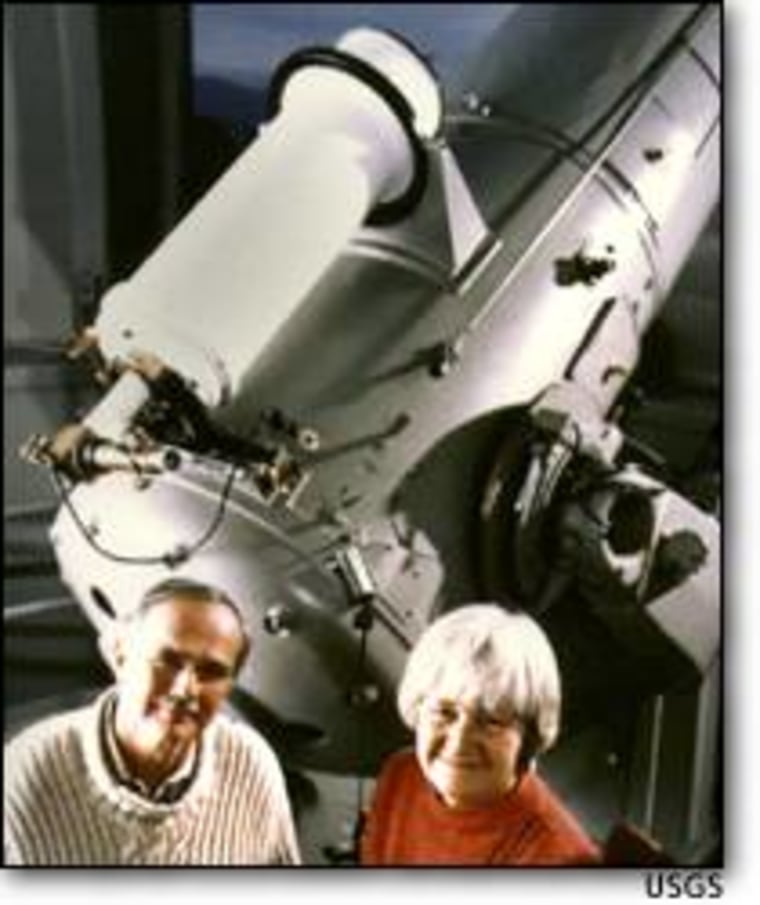Colleagues of a late researcher noted for his expertise on outer-space collisions came up with an astronomical way to honor his memory. A vial carrying an ounce of Eugene Shoemaker’s ashes slammed into a moon crater at 3,800 mph, riding shotgun along NASA’s Lunar Prospector science craft.
“He is the very first human inhabitant of Earth to be laid to rest on another celestial body,” said Carolyn Porco, a University of Arizona professor and Shoemaker’s colleague in NASA’s Voyager missions. “That’s very significant because it says we have arrived at our place in the solar system, the solar system is our own and it’s beckoning us.”
It was Porco who spearheaded the tribute effort and designed an epigraph that accompanies the ashes of Shoemaker, who died two years ago in a car crash while crater-hunting in Australia.
Credited along with his wife for the discovery of about 20 comets and 800 asteroids, Shoemaker gained worldwide fame as a co-discoverer of Comet Shoemaker-Levy 9, which slammed into Jupiter in 1994.
Lunar Prospector hit the moon at 5:52 a.m. ET July 31, 1999.
David Morse, spokesman for NASA’s Ames Research Center, called the memorial “a special honor for a special human being.”
Applied to be astronaut
Shoemaker, a geologist by training, applied to be an astronaut in the 1960s but was rejected because of a medical problem. He later worked on several U.S. space missions, including the Apollo missions to the moon. He taught Apollo astronauts about craters.
Shoemaker said shortly before his death the biggest disappointment in his life was “not going to the moon and banging on it with my own hammer.”
“Grown men have told me they’ve been moved to tears when they heard this story, of the man who wanted so badly to go to the moon,” Porco said. “Through no fault of his own he was taken out of the running. Thirty years later, he finally will get there.”
NASA officials believe the polycarbonate vial containing Shoemaker’s remains pulverized on impact with the wall of the crater.
“It may literally be buried,” said Lisa Chu-Thielbar, Prospector outreach coordinator.
There was no sign that any of Shoemaker’s ashes bounced up in a cloud of soil and, perhaps, water vapor on impact — the focus of the Lunar Prospector’s swan-song experiment. NASA focused the Hubble Space Telescope on the impact to try to detect water from lunar ice that might have been spread by Prospector’s crash.
The cylindrical container that carried Shoemaker’s remains was manufactured by Celestis Inc., a Houston company that has used commercial rockets to launch into space the cremated remains of 55 people, including “Star Trek” creator Gene Roddenberry and 1960s drug guru Timothy Leary.
‘Man in the moon’
Shoemaker’s wife, Carolyn, attended the launch of Prospector on Jan. 6, 1998, with her children and grandchildren. At the time, she said her husband would have been thrilled about having his ashes rest forever on the moon.
“He’s going to be the man in the moon to us,” Carolyn Shoemaker said.
Porco’s epigraph, a laser-etched piece of brass foil, was wrapped around the vial containing Shoemaker’s remains. It depicts Meteor Crater near his home in Flagstaff, Ariz., and the Hale-Bopp comet.
It also has these lines from Shakespeare’s Romeo and Juliet:
And, when he shall die,
Take him and cut him out in little stars,
And he will make the face of heaven so fine
That all the world will be in love with night,
And pay no worship to the garish sun.
